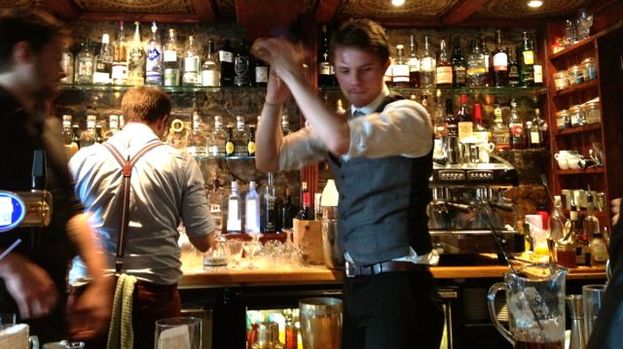A dozen years ago my wife and I visited a couple who had renovated a hoary old estate in the Perigord, deep in the Mother Goosiest part of the French southwest. They subsequently fitted out the house and stables as an upscale B&B with fixtures and amenities charming enough to wring tears of joy from Martha Stewart. We were on assignment for the Boston Globe’s food pages.
The wife of the pair, an Aussie, had created a series of cookbooks for Williams-Sonoma. Her British husby had had an interesting career as a a journalist (guy could tell a story). They were old school gourmands and made a colorful couple, especially since they enjoyed a bit of public conjugal sniping — periodically referring to each other in the third person as Rude Robert and Wonderful Wendeley.
One night at supper, they regaled us with tales of guests delightful and horrid. In the latter category was a fellow Australian who, near the end of dinner, gathered several bottles of rather good red wine together and, as if to make a point that all this business about the sacred individuality of wine was bollocks, poured them all into a decanter together. Robert and Wendeley told the story as if they considered the act a kind of crime against humanity. Our hosts had never witnessed an act of barbarity to compare with it.
Years later I was in The People’s Pint in Greenfield, Mass. — a place where brewing is taken very seriously indeed) and watched as a barkeep cheerfully mixed one draft beer with another right at the taps. Several apparently drinker-approved beer blends were on the menu – though some seemed to be improvised on the spot. No one blinked an eye. I wondered why if cocktail bars and brew houses do it, why can’t wine drinkers?”
The really strange thing about this is that winemakers routinely mix one wine with another. Unless they’re preparing a field blend, winemakers typically vinify individual lots of wine separately with the intention of creating components they can later combine into a well-tempered blend. In some cases they combine wines from the same property, perhaps from contiguous vineyards (think Bordeaux).
In others, the wines may be assembled from widely diverse properties (think Grande Marque Champagne). In a simple French vin de table, there’s almost no telling what might be in the bottle. As a bartender or a consumer, however, wine etiquette gives you no right to mix wine wine at the point of service. How have we arrived at this rather strange and stifling state of affairs?
Our hosts had never witnessed an act of barbarity to compare with it.
You might say that it has something to do with respect for the unique individuality of wines, with vintage variation, with that special something we know today as terroir. And this would be a good defense against mixing wine, except for the fact that all these are precisely the same reasons why winemakers blend so assiduously. Wines are separated into lots in full cognizance of their individuality, the specific characteristics each uniquely contributes. If such individuation didn’t exist, blending would be pointless.
“Ah,” you say, but some wines are too good on their own to be muddled by the addition of a ‘correctives.'” I agree. But (a) only a tiny amount of wine fits this description, and (b) I’m not recommending you take up the practice. I’m merely asking why it is that wine alone is excluded — or nearly so — from the category of drinks that can be mixed without committing an act of barbarity.
My own suspicion is that the development and adoption of the single-serve bottle has something important to do with this. Before bottles became widespread inns, restaurants, and taverns — even households — bought wine in barrels and drew from them to supply the table. Who can doubt that those charged with maintaining the condition of wine in the cellar would not have used one cask to top-off another and so make it all keep a bit longer? And what rational, economy-minded tavern or inn keeper would have refrained from mixing one wine with another if he thought it would make it more palatable and saleable?
The single serve solution provided by bottle and cork was in part an attempt to frustrate unscrupulous types from tampering with the better sort of wine once they left their estates — a way of insuring their integrity. But the practice may have contributed to the notion that any manipulation of wine after it was once bottled constituted a kind of tampering, even when it was just honest, out-in-the-open experimentation.
Somewhere along the line winemakers and negociants — consciously or no — succeeded in convincing us that they and they alone have the talent, the skill, the savoir-faire to decide what you will and I will drink and that while its fine for them to tinker to their heart’s content, it’s out of the question for us to take this holy office into our own hands – to participate, even in this very modest way, in the making of our own wine.
I have the feeling that one of these days some fearless mixologist (it won’t be a somm) is going to look in the direction of the wine cellar and wonder what he could do with the materials stored there. And when that happens, mixing one wine with another at the point of consumption will no longer be a taboo. It will be a trend.
